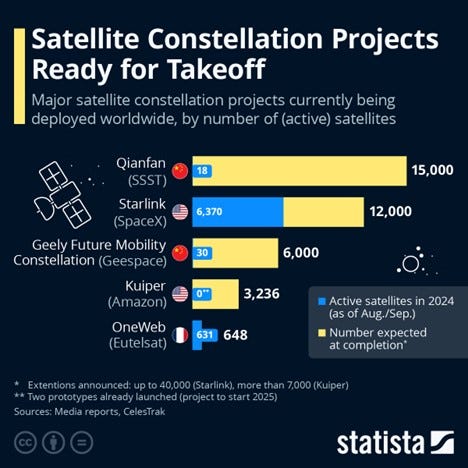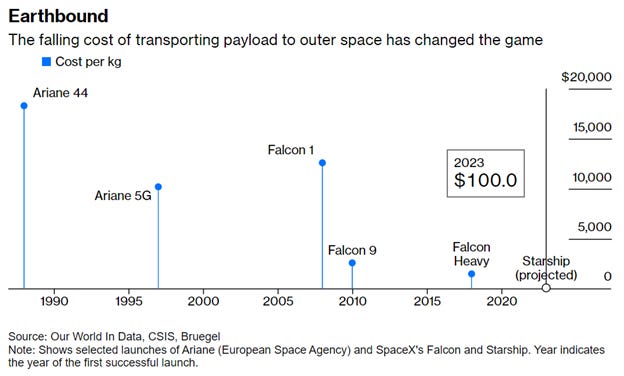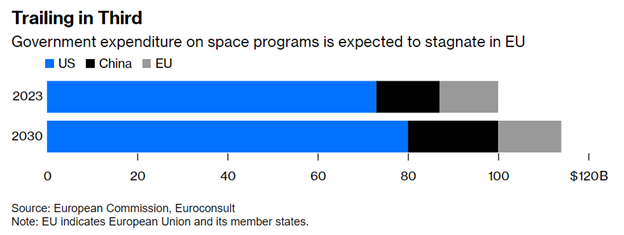Can China catch Elon Musk and Starlink?
Executive Summary:
Space X enjoys a near-monopoly on space launches. The company, founded by Elon Musk, has raced ahead of rivals in Europe and North America by driving down the cost of lifting payloads into orbit.
SpaceX's Starlink system boasts over 6,000 satellites in low-earth orbit, and provides high-quality internet service to the most remote areas of the world.
Starlink is also profitable, and is quickly becoming the global industry standard for heavy industry, maritime, aviation, logistics, search and rescue, and even military operations.
China is aggressively attempting to catch up, with huge investments into research and development of reusable rockets, with ambitions to build even larger constellations of low-earth orbit satellites.
Report:
This is a map of Starlink’s satellites in the sky, right now. These satellites are in low-earth orbit, or LEO. Starlink is part of Space X, which is one of Elon Musk’s companies.
This constellation of Starlink satellites has connected the world with low-cost internet coverage. At Starlink’s company page, the system is clearly marketed to users who are not currently being served by other telecom providers. Rural broadband service costs $120 per month, almost anywhere in the world. Other services are Roam with Starlink, Starlink for boats, Starlink for airlines and private jets, and Starlink for governments.
So the Starlink system is up and running, and has thousands of satellites in orbit, with 2.7 million customers in 75 countries. And the system is now paying for itself, with free cash flow estimated at $600 million for the year.
According to analysts, Starlink’s success derives from three competitive advantages. First, SpaceX and Starlink both feature a high degree of vertical integration. Vertical integration is the extent to which a company produces everything it needs in-house. Second, Starlink is designed for manufacturing cheaply. And third, Starlink produces at scale, and can scale up quickly when new innovations are found and employed.
Let’s observe right away, that these are three areas in which Chinese companies also excel. And Starlink is executing them so well that they have more or less put the European space agencies out of business. Airbus just laid off 2500 people in its Space Division, and says that they cannot compete against Space X. Space X has far more advanced technology compared to Europe.
Politico and Spectator studied the problems Europe had up against Space X and the links are below. Here’s the money: TechCrunch and Bloomberg report that Space X will earn $3 billion in 2024 on $15 billion in revenues.
This means that Space X and Starlink are now generating huge profits, which will in turn fund more innovation and more launches. It goes beyond all that, though. Elon Musk’s success with Starlink is disruptive in lots of other ways. European regulators earlier this month wrote to US officials, and complained that Starlink was operating outside its prescribed frequency bands, and that this is causing communications problems with Europe’s cellular service carriers. Spurious emissions, as they’re called, are causing interference with users on other platforms there in Europe.
The second issue is one of industry standard. If Starlink becomes the default service provider for maritime and aviation and search and rescue and for anyone else not living nearby cell towers or broadband providers, it will be very difficult for competing companies or standards to dislodge Starlink later. If you’re a shipping company or an airline or a search and rescue team and you’ve been a Starlink customer for years, you’re not likely to switch, even if it costs less, because it’s just too risky if something goes wrong. So Starlink for now is the platform for all these users.
The third question involves what Elon Musk might be up to with his purchase of Twitter, which he immediately renamed X. It seem a logical step to bundle Starlink and X (Twitter) to be a dominant global search and mapping engine, as well as a news and information and communications portal.
The final issue is one we are seeing play out in Ukraine. Starlink is such a powerful and such a comprehensive system that the military applications are obvious, and therefore so are the follow-up questions from that. What happens, for example, if a war is going on between two Starlink customer governments? Can Starlink—a US company—be told by American regulators or military officers to turn off service, somewhere?
Any one of those reasons, let alone all of them, would be sufficient as a powerful motivator for China to catch up, and to build their own constellations of satellites in low-earth orbit. This infographic is from Statista and Zerohedge and shows where everyone stands now in the satellite space race.
Qian’fun is China’s most ambitious project, to put at least 15,000 satellites into orbit. SSST is the company leading the effort for that system. They’ve deployed 18 so far, so a long way to go. Starlink is about halfway to its goal of 12,000. Geely is another Chinese company, with 30 in operation out of 6,000 planned. Amazon plans to build a system and has some prototypes that have worked, but also have had rocket production problems. And there’s Europe on the board, with fewer than 10% of what Starlink has got, even though they started first.
What has driven the success of Starlink is reusable rockets. Being able to use the rockets over and over again drives down the cost of launches. Falcon rockets are the ones developed by Starlink, and their Falcon 9 is now the most commonly used rocket in the world.
SpaceX has basically a monopoly on launches now, and that includes Starlink satellites. The metric that the industry uses is cost per kilogram: how much does it cost to launch a kilogram of payload into orbit. And Falcon’s payload launch cost is dropping toward zero. This is reusable rockets, again, and a company organization at Space X with a very high level of vertical integration and manufacturing efficiency.
In order to catch Space X, China needs to do what Europe did not do, which is figure out how to build reusable rockets. So Chinese companies are doubling down on those efforts. There are two companies we have found who have recently announced progress there. The first, Landspace Technology was profiled in Space and Defense, are out of Beijing and have successfully tested vertical takeoffs and landings of their vehicle. China’s government is encouraging public and private companies to develop reusable rockets. This is a common top-down strategy here in China, across all industries: the central government provides funding and resources for dozens of companies to tackle a problem, in this case the design and mass production of reusable rockets.
The second company is here, written up on Space.com, and that company is CAS Space. Their rocket has a payload of 8 tons, designed for LEO satellite constellations and cargo flights. There are no doubt other companies, perhaps many other companies, that are doing this same research.
China’s spending on space programs already exceeds what the whole of the European Union spends, and remember again that everything here just costs a lot less. The technology just costs less here. It costs a lot less to hire aerospace engineers in China than in the United States or Europe, so it seems like the United States has a huge spending advantage and that implies we’ll just stay ahead, but that ignores how much value is generated from that spending.
That said, the fact that Space X and Starlink are already making big profits—that is critically important. The system is paying for itself, now. SpaceX is already halfway to blanketing the world with coverage, and SpaceX is far ahead on the technology that gets the satellites up into orbit to begin with. They’re also far ahead on commercializing the system. For now, at least.
Resources and links:
Starlink satellites in real time https://satellitemap.space/?constellation=starlink
Starlink home page
https://www.starlink.com/us/technology
Zerohedge, French Media Blames SpaceX For 2,500 Airbus Layoffs As Elon Musk Leads Rocket Race
https://x.com/ajtourville/status/1846702528505041230
SpaceX’s mission to improve Starlink gets pushback from Europehttps://www.teslarati.com/spacex-starlink-direct-to-cell-europe/
Politico, How Europe’s rocket program lost big to Elon Musk: The inside story https://www.politico.eu/article/how-europe-screwed-up-its-rocket-program/
TechCrunchInternal pre-Starlink SpaceX financials show big spending on moonshot bets
Space.com, Chinese company CAS Space takes steps toward 1st launch of reusable rocket
https://www.space.com/china-cas-space-reusable-rocket-progress
Space and Defense, Another Step Forward – China Advances its Reusable Rockets
https://spaceanddefense.io/china-advances-reusable-space-technology/
Bloomberg, In Space, No One Can Hear Musk's Rivals Scream
https://www.bloomberg.com/opinion/articles/2024-10-18/musk-and-spacex-rivals-can-t-seem-to-catch-up
Zerohedge, Satellite Constellation Projects Ready for Takeoff
https://www.zerohedge.com/technology/satellite-constellation-projects-ready-takeoff
Statista, Satellite Constellation Projects Ready for Takeoff
https://www.statista.com/chart/33246/satellite-constellation-projects/
Starlink, meet Qianfan: China’s bold bid to catch up in the satellite race https://www.thinkchina.sg/technology/starlink-meet-qianfan-chinas-bold-bid-catch-satellite-race
Aviation Week, Why Is The U.S. Space Industry So Obsessed With Vertical Integration?
https://aviationweek.com/space/commercial-space/why-us-space-industry-so-obsessed-vertical-integration-0





